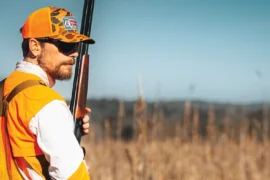From our July/August 2025 Issue
I’ve harbored a relatively quiet interest in air guns since I was a kid. I remember the time my father returned from West Germany in the ’70s and surprised me with an RWS air rifle. While other kids were roaming their backyards with Red Ryders, I had a high-precision weapon with a zeroed-in scope.
The world of air guns has grown dramatically since then. An exploding fraternity of pneumatic enthusiasts is more than plinkers and Olympic hopefuls. These shooters are now dedicated hunters capable of bringing down prey as big as water buffaloes with their big-bore rifles up to .72 caliber. But for the most part wingshooters have been left out. Enter Seneca’s Wing Shot II, which was released in 2017.
The Wing Shot has a profile that combines the looks of an over/under and an autoloader. The action along with the sliding bolt (which cocks the gun) is reminiscent of a Remington 1100. The stacked tubes include a lower tube that is an air reservoir and a top barrel that can be loaded with a plastic shotshell loaded with No. 6 or 8 shot or a .50-caliber slug. The shell slides into a breech that unscrews just in front of the action. With a smooth 22.5” barrel and a removable choke (which produces a tight 12” pattern at 20 yards and must be removed before shooting slugs), this single-shot air gun has a ventilated rib and a 244cc air reservoir that can be monitored with a built-in manometer (pressure gauge). The nearly 7.5-pound gun requires a separate toaster-size air compressor to charge the reservoir—which once filled to maximum safe pressure (2,700 PSI) is good for approximately eight shots before requiring recharging. For those planning to take the Wing Shot into the field, the need to recharge will be a challenge even with the separate jumper cables that allow DC charging from a truck or ATV.
Seneca reports that loads fired from the Wing Shot travel 1,130 fps—not much different from a typical .410 target load. This is where we make the point that air guns are not toys. The Wing Shot II shotshell has 360 foot-pounds of energy (FPE) and a slug has 235-plus FPE. (Projectiles fired with at least 58 FPE are considered lethal.) I fired several rounds of No. 6s and broke one open and counted 76 pellets. Seneca also has empty shotshells available for creating custom loads.
I put the Wing Shot to the test by firing dozens of rounds at targets. The wooden stock is a bit short, with a length of pull of 13¾” to the back of the unnecessary recoil pad. With the small shot loads and very tight patterns, hitting the moving targets at first was tricky. But as I became more and more familiar with it, the hits became more consistent and satisfying. Also of note is that while the gun is not as loud as a standard shotgun, the noise is significant—louder than a standard pneumatic nail gun.
Do you need an air shotgun? Probably not. Is the Wing Shot effective for shooting moving targets? It’s even more challenging than a standard .410, and the frequent and time-consuming recharging is a hindrance. The one use that it seems perfectly suited for is small game like squirrels and rabbits and for pesky rodents.
The Wing Shot II retails for $800, and the compressor is $500. Guns and ammunition can be shipped directly to buyers and don’t require an FFL. For more information, visit pyramydair.com.
Read our Newsletter
Stay connected to the best of wingshooting & fine guns with additional free content, special offers and promotions.





I love the color and detail of the shotgun. and to think that the hard work that they put in to making an air type shotgun that can shoot bolts is amazing. I think Seneca is a great company and should come up with more air type shotguns like co2.